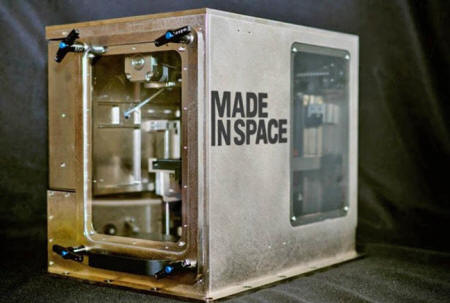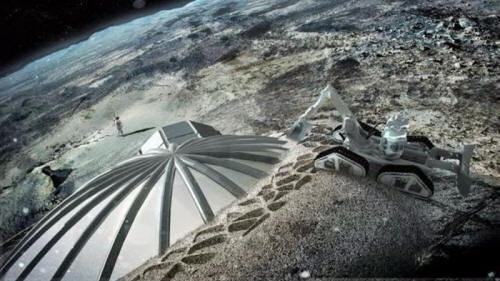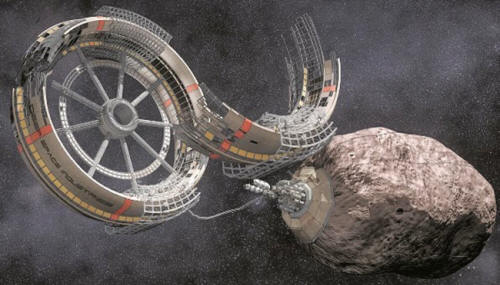|

by Brian Berletic
September 25, 2014
from
Bioitmag Website

The first 3D printer to reach Earth's orbit was launched this
week aboard
SpaceX's Dragon cargo ship.
Destined for the International Space
Station (ISS), the 3D printer (designed
by 'Made in Space') will allow astronauts to experiment with
fabrication in orbit. While the 3D printer will be limited in terms
of materials and the size of the objects it can print, and with its
prints of limited utility to astronauts, it is still a crucial first
step on a road toward immense implications.
Below are 3 of these implications.
1. Objects on Demand
Until now, any object or tool
required on space missions either had to be rigged from existing
objects on hand or launched into orbit.
Rigging objects is a solution of last resort, something that
Apollo 13 astronauts were famously required to do in order to
save their ill-fated mission to the moon.
Launching objects into
orbit is a costly and time-consuming proposition. But with a 3D printer, this is no
longer a problem.
As long as input material is on hand, any
object astronauts are capable of designing or have on digital
file, can be fabricated on demand, aboard the space station.
Made in Space is currently working
on a system that will recycle spent input material making it
possible to print out and reprint designs perpetually.

Made in Space's 3D printer is shown here
being tested via
microgravity parabolas,
essentially when
an airplane nose-dives at a specific rate
to simulate zero
gravity in Earth's orbit.
For carefully planned missions on
the ISS and with regular resupply missions able to provide
astronauts with everything they could possibly need, this is not
so much an issue.
However, on longer missions, to say
the Moon or Mars where mission parameters may be unpredictable
and resupply missions are out of the question, the ability to
fabricate replacement parts, tools, and other objects can make
all the difference.
2. "Teleporting" Objects
Because a 3D printer works by taking
a digital file and converting it into layers of printed
material, astronauts on space missions could use files from
three possible sources.
-
They could design the object
themselves with 3D design software.
-
They could pull it from a
library of objects on their hard drive.
-
Or third and more
interestingly, they could have it sent to them from
Earth where engineers could design, modify, and
re-modify any idea they can imagine.
Instead of sending a physical
article to the astronauts which may not even be possible, they
can instead send the digital file via communication signals at
the speed of light.
Once received, the 3D printer can
begin printing, resulting in an object designed on Earth,
fabricated and placed in the hands of astronauts hundreds of
thousands of miles away.
3. Large Scale Construction
One of the biggest limitations on
what we can build in space is the amount of material we can
launch into orbit from which to build.
What if instead, fabrication tools
like 3D printers could be launched and with a limited amount of
material, fabricate larger tools to begin heavy construction in
orbit. Asteroids and other sources of material already beyond
Earth's gravity could be utilized to construct everything from
spacecraft to orbital colonies.
Amid this process, smaller
Earth-launched fabrication systems could scale themselves up in
both numbers and size to meet any demand.
Plausibility?
The first two implications should be self-evident.
We already have a 3D printer in orbit
now that soon will be printing objects on demand. In addition to
tests run by mission control and astronauts, design contests among
students on Earth are ongoing and finalists will send their ideas
via data-link to the ISS to be printed out aboard.
In essence, students will "teleport"
their designs to astronauts with the final product printed out in
orbit and placed in the hands of the ISS' crew.

The third implication may still be a
ways off, but several private space firms are already researching
just how to use fabrication techniques like 3D printing and the
knowledge gained from Made in Space's printer to build everything
from
a lunar base to a floating space colony "spun" from captured
asteroids.
Renowned architectural firm
Foster + Partners for example,
has teamed up with the ESA to see
how feasible 3D printing is with lunar soil.
The concept they developed includes an
inflatable bladder that forms a dome upon which 3D printed material
is deposited before hardening and providing a protective covering
for the structure.
There are already large-scale
architectural 3D printers on Earth and coupled with lessons learned
from Made in Space's 3D printer now in orbit,
devising ways of
printing architecture beyond Earth's gravity is
the next logical step.
Deep Space Industries (DSI) is already developing a fleet of
autonomous and remotely operated spacecraft to search out and
explore asteroids for their potential mining and use as building
materials.
During DSI's initial public roll out,
concept art depicted a torus-shaped space habitat (known as a
Stanford torus) being "spun" out of an asteroid.
While the concept art doesn't specify
what means of fabrication the space habitat was being "spun" with,
DSI has stated that it too
is preparing
to use 3D printing as a means of large-scale fabrication in
space for both parts and whole objects, and out of a variety of
materials including metals
While the initial prints aboard the ISS may not be overly
impressive, the launch of Made in Space's 3D printer into Earth's
orbit and its use is a necessary first step on a much larger and awe
inspiring journey.
Just as the Wright Brothers' first
flying machine was considered a novelty of little use, so too may
the first 3D printer in space. But just like the Wright Brothers'
first flying machine, the first 3D printer in space carries with it
immense, potentially paradigm-shifting implications.
The former ushered in the dawn of an age
of human flight, the latter may usher in
the permanent settlement of humanity amongst the stars.
|




